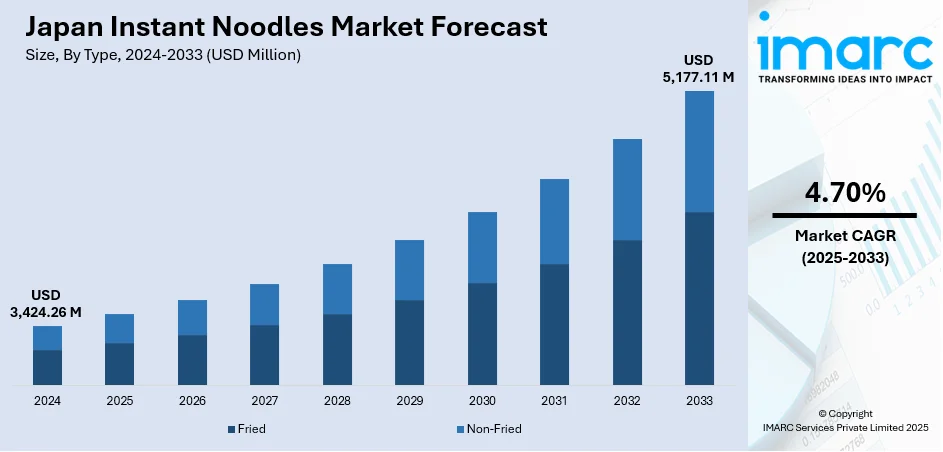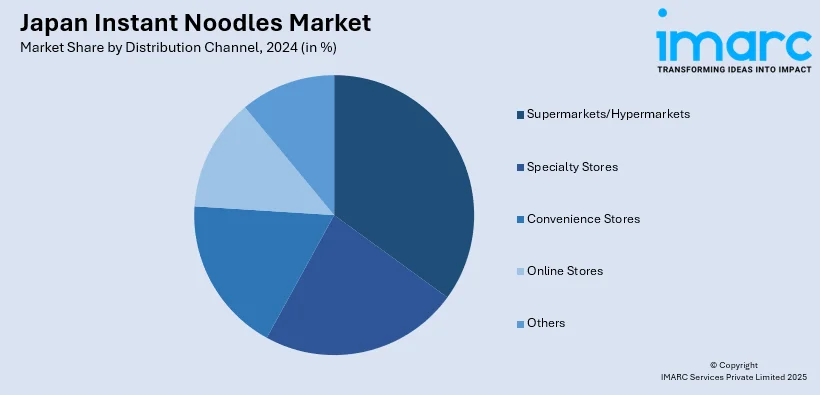
Japan Instant Noodles Market Size, Share, Trends and Forecast by Type, Distribution Channel, and Region, 2025-2033
Japan Instant Noodles Market Overview:
The Japan instant noodles market size reached USD 3,424.26 Million in 2024. Looking forward, IMARC Group expects the market to reach USD 5,177.11 Million by 2033, exhibiting a growth rate (CAGR) of 4.70% during 2025-2033. The market is being driven by deep cultural integration that makes instant noodles a staple comfort food, alongside continuous product innovations, such as the introduction of health-focused options and unique flavors that cater to evolving consumer preferences and lifestyle demands in a highly convenience-oriented, tech-savvy, and trend-sensitive society.
|
Report Attribute
|
Key Statistics
|
|---|---|
|
Base Year
|
2024
|
|
Forecast Years
|
2025-2033
|
|
Historical Years
|
2019-2024
|
| Market Size in 2024 | USD 3,424.26 Million |
| Market Forecast in 2033 | USD 5,177.11 Million |
| Market Growth Rate 2025-2033 | 4.70% |
Japan Instant Noodles Market Trends:
Cultural Integration and Longstanding Culinary Habits
Instant noodles in Japan are not merely a quick meal; they have become deeply rooted in the country's food culture. This is a key driver of market growth. Across generations, these noodles have undergone a transformation from emergency or budget food to a staple present in almost all Japanese homes. This longstanding familiarity has built trust and acceptability. Psychologically, Japanese consumers connect instant noodles with comfort, nostalgia, and even innovation. Local flavors, such as miso ramen, shoyu (soy sauce flavor), tonkatsu (pork bone broth flavor), and curry-based options, appeal to regional and traditional preferences, helping the product to be perceived as authentically Japanese. Additionally, instant noodles are ubiquitous in pop culture, school lunches, and convenience store aisles, reinforcing their relevance in daily life.

To get more information on this market, Request Sample
Technological Innovation and Product Diversification
Substantial technological innovations and diversification are further driving the market. Japan is renowned worldwide for its cutting-edge food technologies and high expectations from consumers for product quality, safety, and diversity. Instant noodles have been a prime beneficiary of this climate, moving well beyond simple flavor packs to sophisticated, gourmet-like cuisine in a cup. Japanese food manufacturers are continually investing in research and development to create new textures, enhance noodle flexibility, replicate authentic broth flavors, and develop innovative packaging solutions. For example, improvements in dehydration methods are making meat and vegetable toppings appear more realistic and air-tight, recyclable packaging are extending shelf-life and ease of use. Brands such as Nissin, Maruchan, and Acecook compete by launching high-quality "premium" instant noodles that respond to the increasing demand for gourmet experiences at home. Some premium products feature rich tonkotsu broths, authentic char siu pork, or ramen-shop-style noodles, reducing the distinction between convenience food and restaurant-quality offerings.
Japan Instant Noodles Market Segmentation:
IMARC Group provides an analysis of the key trends in each segment of the market, along with forecasts at the region/country level for 2025-2033. Our report has categorized the market based on type and distribution channel.
Type Insights:
- Fried
- Non-Fried
The report has provided a detailed breakup and analysis of the market based on the type. This includes fried and non-fried.
Distribution Channel Insights:

- Supermarkets/Hypermarkets
- Specialty Stores
- Convenience Stores
- Online Stores
- Others
A detailed breakup and analysis of the market based on the distribution channel have also been provided in the report. This includes supermarkets/hypermarkets, specialty stores, convenience stores, online stores, and others.
Regional Insights:
- Kanto Region
- Kansai/Kinki Region
- Central/Chubu Region
- Kyushu-Okinawa Region
- Tohoku Region
- Chugoku Region
- Hokkaido Region
- Shikoku Region
The report has also provided a comprehensive analysis of all the major regional markets, which include Kanto Region, Kansai/Kinki Region, Central/Chubu Region, Kyushu-Okinawa Region, Tohoku Region, Chugoku Region, Hokkaido Region, and Shikoku Region.
Competitive Landscape:
The market research report has also provided a comprehensive analysis of the competitive landscape. Competitive analysis such as market structure, key player positioning, top winning strategies, competitive dashboard, and company evaluation quadrant has been covered in the report. Also, detailed profiles of all major companies have been provided.
Japan Instant Noodles Market News:
- February 2025: Samyang Foods, a South Korean instant noodle manufacturer, launched its new brand "MEP" in Japan. The brand's debut includes the introduction of premium instant noodle products, such as the "MEP Premium Spicy Ramen", which features a rich broth and high-quality ingredients.
- June 2024: Nissin Foods introduced a pufferfish-flavored instant noodle in Japan, offering the luxurious and potentially poisonous delicacy, typically priced at up to JPY 20,000 in restaurants, for just JPY 298. The product contains a packet of oil infused with the "essence" of pufferfish, complemented by dried chicken meatballs, spring onions, shredded egg, and a yuzu-flavored soup base.
- September 2023: Nissin Foods introduced caffeinated instant noodles in Japan. The new product includes two flavors: garlic and black pepper yakisoba and ginger keema curry rice. These offerings are designed to provide an energy boost, catering to consumers seeking convenience and enhanced alertness, such as gamers.
Japan Instant Noodles Market Report Coverage:
| Report Features | Details |
|---|---|
| Base Year of the Analysis | 2024 |
| Historical Period | 2019-2024 |
| Forecast Period | 2025-2033 |
| Units | Million USD |
| Scope of the Report |
Exploration of Historical Trends and Market Outlook, Industry Catalysts and Challenges, Segment-Wise Historical and Future Market Assessment:
|
| Types Covered | Fried, Non-Fried |
| Distribution Channels Covered | Supermarkets/Hypermarkets, Specialty Stores, Convenience Stores, Online Stores, Others |
| Regions Covered | Kanto Region, Kansai/Kinki Region, Central/Chubu Region, Kyushu-Okinawa Region, Tohoku Region, Chugoku Region, Hokkaido Region, Shikoku Region |
| Customization Scope | 10% Free Customization |
| Post-Sale Analyst Support | 10-12 Weeks |
| Delivery Format | PDF and Excel through Email (We can also provide the editable version of the report in PPT/Word format on special request) |
Key Questions Answered in This Report:
- How has the Japan instant noodles market performed so far and how will it perform in the coming years?
- What is the breakup of the Japan instant noodles market on the basis of type?
- What is the breakup of the Japan instant noodles market on the basis of distribution channel?
- What is the breakup of the Japan instant noodles market on the basis of region?
- What are the various stages in the value chain of the Japan instant noodles market?
- What are the key driving factors and challenges in the Japan instant noodles market?
- What is the structure of the Japan instant noodles market and who are the key players?
- What is the degree of competition in the Japan instant noodles market?
Key Benefits for Stakeholders:
- IMARC’s industry report offers a comprehensive quantitative analysis of various market segments, historical and current market trends, market forecasts, and dynamics of the Japan instant noodles market from 2019-2033.
- The research report provides the latest information on the market drivers, challenges, and opportunities in the Japan instant noodles market.
- Porter's five forces analysis assist stakeholders in assessing the impact of new entrants, competitive rivalry, supplier power, buyer power, and the threat of substitution. It helps stakeholders to analyze the level of competition within the Japan instant noodles industry and its attractiveness.
- Competitive landscape allows stakeholders to understand their competitive environment and provides an insight into the current positions of key players in the market.
Need more help?
- Speak to our experienced analysts for insights on the current market scenarios.
- Include additional segments and countries to customize the report as per your requirement.
- Gain an unparalleled competitive advantage in your domain by understanding how to utilize the report and positively impacting your operations and revenue.
- For further assistance, please connect with our analysts.
 Request Customization
Request Customization
 Speak to an Analyst
Speak to an Analyst
 Request Brochure
Request Brochure
 Inquire Before Buying
Inquire Before Buying




.webp)




.webp)












